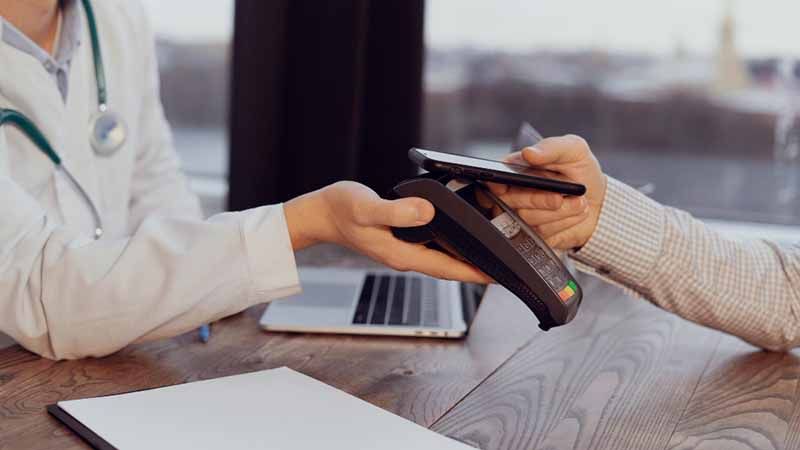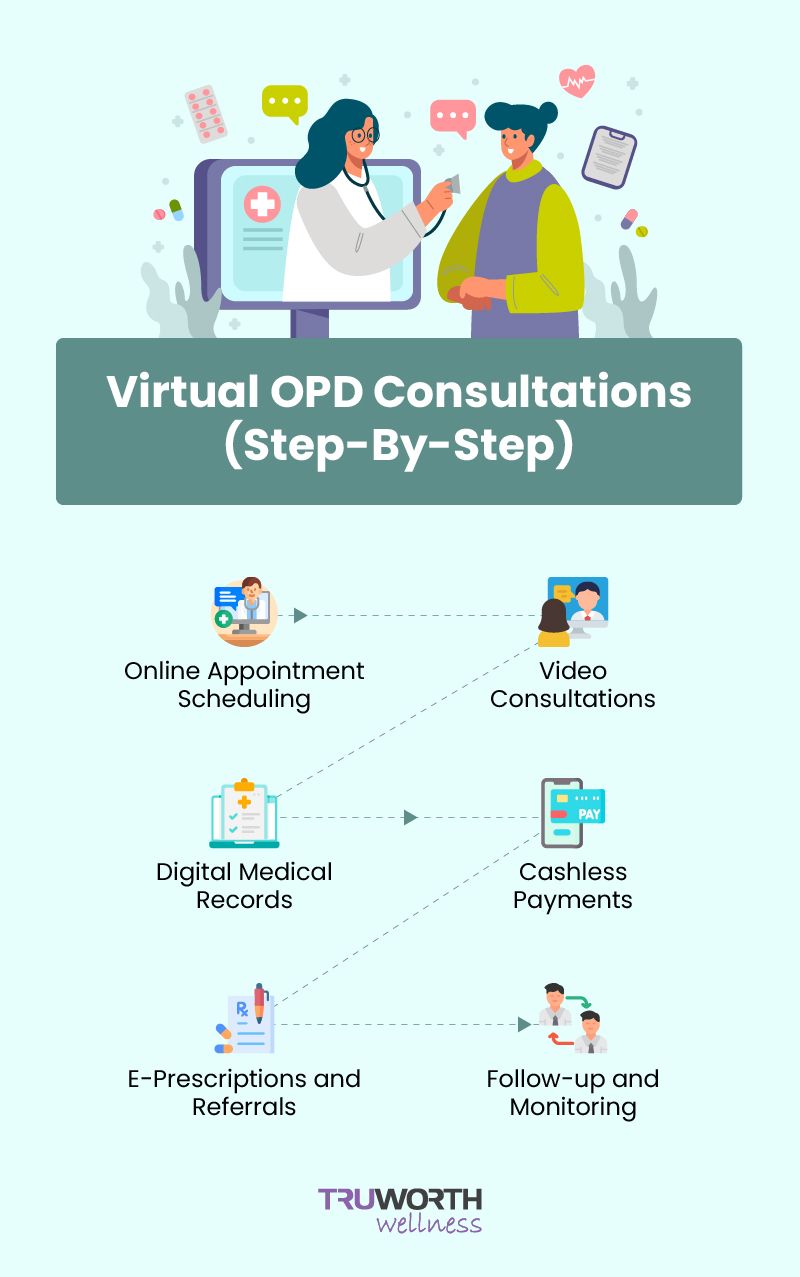Cashless OPD Solutions: Transforming Employee Healthcare

The days of crowded waiting rooms, piles of paperwork, and fumbling with cash to pay for medical expenses are gone. In modern healthcare, cashless outpatient department (OPD) programs have emerged as a revolutionary solution, transforming how employees access and manage healthcare services. In this blog, we'll take you on an immersive journey through the world of cashless OPD. We will explore their unique advantages and discover what sets them apart.

Evolution of Healthcare Access: Embracing Digital Transformation
In a rapidly evolving world where technology plays an increasingly prominent role in our daily lives, it is imperative that the healthcare industry keeps pace with technological advancements. One notable development in this regard is the introduction of cashless outpatient department (OPD) programs. As a result, these programs represent progress, heralding an era of digital transformation in the healthcare industry.
By shifting from traditional payment methods to cashless transactions, these programs bring numerous benefits to both healthcare providers and patients. One of the key advantages is the streamlining of the entire outpatient experience. In the traditional system, patients often have to wait in long queues to make cash payments at the OPD desk, causing inconvenience and delays. However, with cashless OPD programs, patients can pay seamlessly and conveniently through digital platforms.
Unleashing Convenience Power: A User-Friendly Digital Platform
Cashless OPD programs place healthcare management power in employees' hands, granting them unparalleled convenience and control. With a user-friendly digital platform at their fingertips, employees can effortlessly navigate through a multitude of healthcare services. From booking appointments with preferred doctors to managing medical records and settling bills, every step is simplified, eliminating time-consuming phone calls or in-person visits.
The integration of cashless OPD simplifies the payment process, reducing the administrative burden on healthcare providers. It eliminates manual cash handling, thereby reducing errors and promoting efficiency. Healthcare facilities can also leverage technology to automate billing and payment systems, enabling real-time transaction tracking, reconciliation, and improved financial management.
Patients can pay for OPD visits using various digital payment methods, including mobile wallets, debit or credit cards, or online banking platforms. This flexibility accommodates different financial preferences and aligns with increasing digital literacy and smartphone penetration worldwide.
Streamlining Administrative Processes: Simplifying Healthcare Benefits
For employers, cashless OPD programs offer administrative benefits. By partnering with healthcare providers and insurance companies, businesses can centralize billing and payment systems, revolutionizing healthcare benefits management. This simplification reduces paperwork, minimizes errors, and optimizes valuable time spent on administrative tasks. As a result, HR departments can shift their focus towards strategic initiatives that drive employee engagement and organizational growth.
It opens the doors to further advancements such as electronic health records, telemedicine, and remote patient monitoring. These advancements rely on seamless digital connectivity and integration.
Unveiling Cost Control and Transparency: Empowering Employers
One of the key advantages of cashless OPD programs lies in their ability to provide employers with enhanced cost control and transparency. By integrating these programs with existing employee benefit schemes, organizations gain real-time access to healthcare expense data. This invaluable information allows employers to make informed decisions regarding benefits coverage, cost-sharing models, and plan customization. It's not just about making sure employees understand the financial aspects of their healthcare coverage, but also about fostering trust and satisfaction.
Furthermore, cashless OPD programs can streamline administrative processes for both employees and employers. Traditional reimbursement models often involve complex paperwork, claim submissions, and reimbursement delays. In contrast, cashless OPD programs simplify the process by directly settling medical expenses with healthcare providers. This reduces the administrative burden on employees and HR departments. This streamlined approach saves time, improves efficiency, and allows employees to focus on their health and work responsibilities.
Empowering Employee Wellness: A Holistic Approach to Health
By encouraging proactive health management, cashless OPD programs can contribute to employees' overall well-being. Early detection and intervention are crucial to managing many health conditions effectively. With easy access to medical care and regular check-ups facilitated by these programs, employees are more likely to detect health issues in their early stages, leading to timely treatment and better outcomes. This can result in reduced healthcare costs in the long run, as preventative measures and early intervention are often more cost-effective than treating advanced or chronic conditions.
Cashless OPD programs often provide a wide range of wellness resources beyond basic medical consultations. These programs may include additional services such as discounted health screenings, preventive care programs, wellness workshops, and access to telemedicine services.
Security and Safety at the Core: Protecting Personal Information
With the rising concerns surrounding data breaches and identity theft, security and privacy are of paramount importance. By implementing robust encryption algorithms and protocols, cashless OPD programs ensure that personal and financial information transmitted and stored within their systems remains secure from unauthorized access.
Moreover, stringent privacy protocols are in place to safeguard personal information throughout the healthcare journey. These protocols dictate how data is collected, stored, accessed, and shared, ensuring that only authorized individuals or entities can access the information. Cashless OPD programs adhere to strict privacy regulations, such as the General Data Protection Regulation (GDPR) and the Health Insurance Portability and Accountability Act (HIPAA), which provide a legal framework for personal data protection.
Knowing that their personal and financial information is confidential and protected, employees can feel reassured and safe while availing of cashless OPD services. This trust not only strengthens the employee-provider relationship but also encourages the widespread adoption of cashless OPD programs, resulting in improved healthcare experiences for individuals and enhanced overall organizational security.
Also Check: The Role of Confidentiality for Successful Employee Assistance Program
Virtual OPD Consultations: Example of a cashless OPD program (Step-by-step)
Cashless OPD programs can extend beyond physical visits to include virtual consultations. Through these programs, patients can schedule appointments online, have video consultations with healthcare professionals, and make cashless payments for these services. Virtual OPD consultations offer convenience for patients, particularly those in remote areas or with limited mobility. This eliminates the need for travel while maintaining access to quality healthcare.

Here's an explanation of how a cashless OPD program with virtual consultations works:
- Online Appointment Scheduling: Patients can access a dedicated website or mobile app to schedule virtual consultations conveniently. They can select a suitable time slot and choose from a list of available healthcare professionals based on their specialization, experience, and ratings.
- Video Consultations: At the appointed time, patients can connect with their healthcare provider through a secure video conferencing platform. This virtual face-to-face interaction allows patients to discuss health concerns, share symptoms, and ask questions. Healthcare professionals can perform virtual examinations by observing physical symptoms, reviewing medical histories, and requesting patients to perform certain actions.
- Digital Medical Records: To ensure seamless communication and access to medical history, patients can upload and store their medical records and diagnostic reports on a secure digital platform. This allows healthcare providers to have a comprehensive understanding of the patient's health status, aiding in accurate diagnoses and personalized treatment plans.
- Cashless Payments: After the virtual consultation, patients can make cashless payments using various methods such as online banking, digital wallets, or credit/debit cards. The payment gateway integrated into the platform ensures secure and hassle-free transactions.
- E-Prescriptions and Referrals: Based on the consultation, if medications are required, healthcare professionals can electronically generate e-prescriptions, which can be easily accessed and fulfilled at a local pharmacy. In cases where specialist referrals are necessary, healthcare providers can send electronic referral letters directly to the concerned specialist. This facilitates a smooth care transition.
- Follow-up and Monitoring: Virtual OPD programs can include follow-up consultations to track progress, adjust treatment plans, or address any concerns that may arise. This can be done through additional virtual consultations or through secure messaging systems where patients can communicate with their healthcare providers.
Conclusion
In an era where convenience is king, cashless OPD programs revolutionize healthcare experiences. By embracing these programs, businesses demonstrate their commitment to providing seamless, accessible, and efficient healthcare services. From simplifying administrative processes and empowering employers with cost control and transparency to promoting employee wellness and prioritizing security, cashless OPD programs